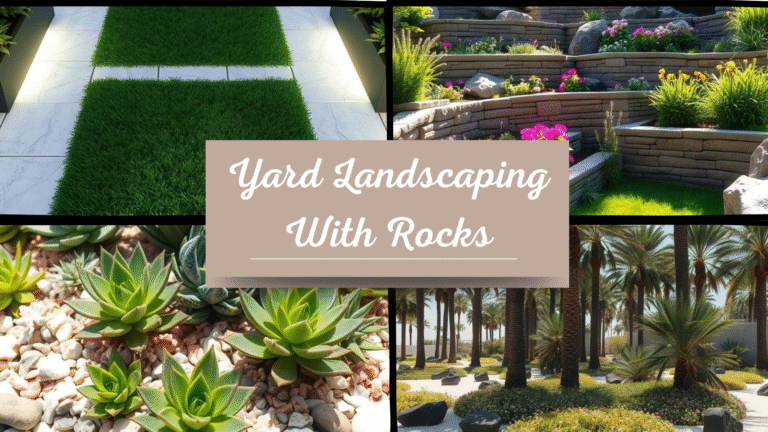Modern Driveway Ideas to Elevate Your Home’s Curb Appeal
A driveway is more than a strip of hardscape—it’s the first design statement your home makes. Modern driveways balance durability with clean lines, subtle textures, and thoughtful planting. The ideas below are crafted for an image-led article: each heading includes a precise image prompt followed by five short paragraphs that explain design intent, materials, drainage, and styling tips. Use them to brief a photographer, direct a contractor, or generate AI visuals that feel realistic and high-end.
1) Permeable Paver Grid with Crisp Geometry
A rectilinear grid reads especially modern. Set modules with consistent joint spacing so the pattern stays calm from every angle. Use polymeric joint sand designed for permeables to maintain porosity without weed growth. Base prep matters more than the surface. Specify an open-graded aggregate base and a choker course to maintain void space. This keeps the system draining in heavy storms and prevents frost heave.
Plant narrow bands of drought-tolerant grasses along the edges. The soft texture offsets the crisp paver lines and hides any minor grade transitions. Keep species low so mirrors and doors clear easily. Finish with a subtle border in the same paver family but a half-step darker. The tonal shift frames the drive like a mat around a photograph and improves wheel alignment visually.
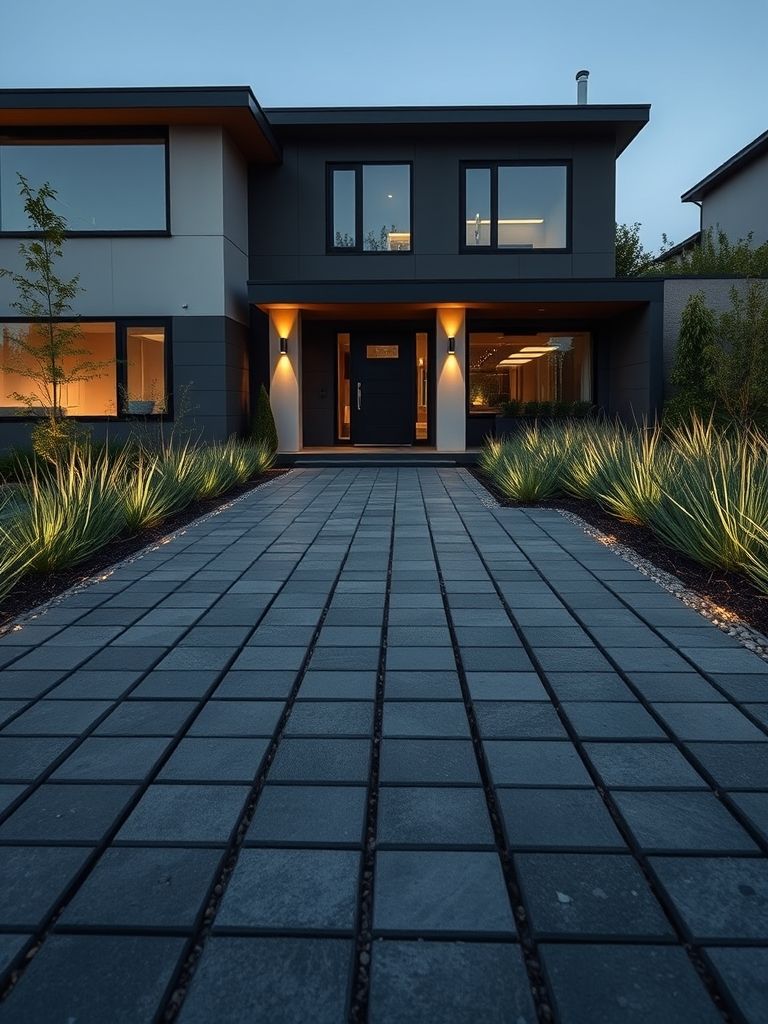
2) Exposed Aggregate Concrete with Clean Control Joints
Control joints are your design language. Lay out a joint plan that aligns with the garage bays and the home’s window rhythm. Saw-cuts at 8–12 feet intervals keep cracking controlled and turn structure into pattern. Specify a penetrating sealer with matte sheen so the stone color deepens without glare. Sealing also reduces staining from leaves and fluids. Reapply every few years for uniform tone.
Edge the slab with a narrow steel or stone band. That tiny reveal feels tailored and prevents spalling at corners from repeated turns. It also creates a clean transition to planting or gravel. If your climate freezes, request air-entrained concrete and proper slope—about 1–2% toward drainage points. Good detailing keeps beauty and performance aligned for decades.
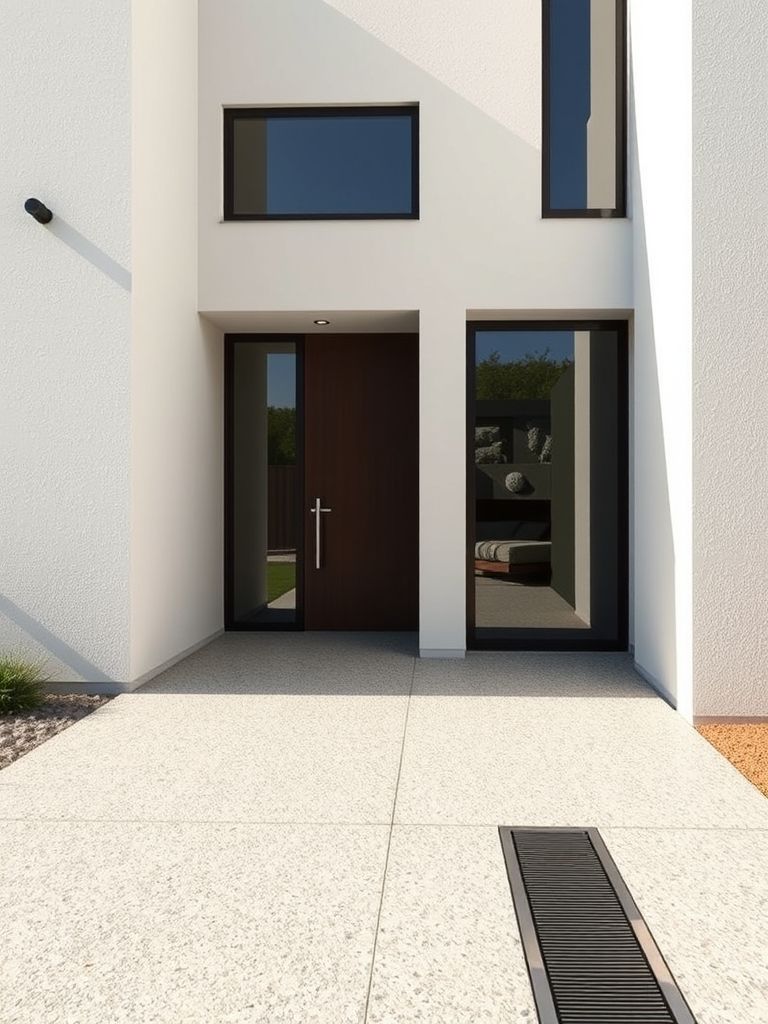
3) Resin-Bound Gravel for Seamless Texture
Choose a blend that echoes your facade—cool creams for light render, darker browns against timber or brick. Samples are essential because aggregate size and mix strongly affect color. Correct base construction is key. You’ll want a compacted sub-base and an open-graded asphalt or concrete substrate that manages moisture. This prevents reflective cracking and puddling.
Edging keeps the minimalist look crisp. Powder-coated aluminum or steel angles form razor-straight boundaries that resist vehicle load. Curves are possible, but keep radii generous for clean lines. Maintain with occasional power-washing and leaf removal. Avoid hot tires sitting in one place on summer afternoons; a breathable sealer can add extra UV stability in sunny climates.
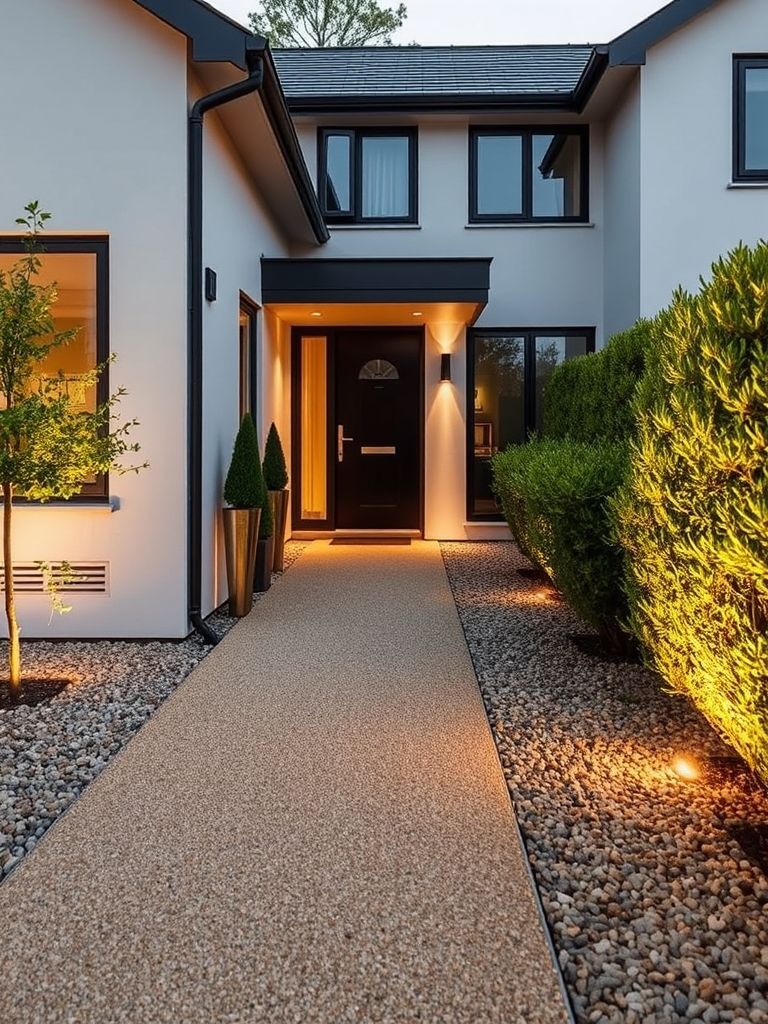
4) Large-Format Porcelain Pavers with Tight Joints
For drive applications, confirm your system is rated for vehicles. Many manufacturers offer 20 mm or thicker units with reinforced installation methods. A pedestal or mortar-set hybrid can handle turning forces. Keep joints minimal and consistent. Use color-matched grout or sand for a barely-there seam that accentuates the slab size. Straight patterning feels architectural; avoid checkerboard contrasts.
Pair porcelain with dark gravel margins to absorb stray grit and drainage splash. The contrast also frames the pale slab field like a gallery plinth. Wash with pH-neutral cleaners to protect finishes. A yearly deep clean brings back the crisp, matte look that modern facades love.
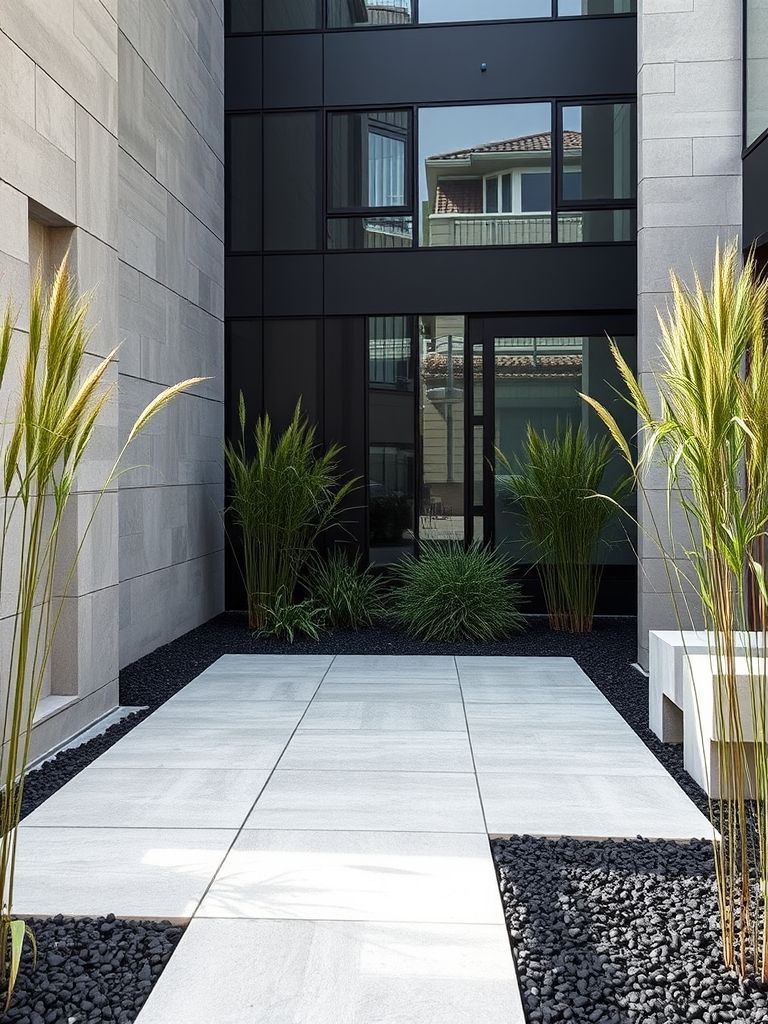
5) Basalt or Bluestone Slabs for Luxe Minimalism
Design with long, linear modules to draw the eye toward the entry. Stagger joints in a running-bond for strength and flow. Keep module widths consistent for a calm composition. Under heavy vehicles, use a reinforced concrete base with thin-set installation. This maintains flatness over time and resists point loads from turning wheels.
Seal only to enrich color, not to create shine. A penetrating, breathable product helps resist oil without plastic-looking reflections. Test a small area first to confirm tone. Balance the weight of dark stone with airy grasses and silver-leaf shrubs. Night lighting should graze, not spotlight, to reveal texture without glare.
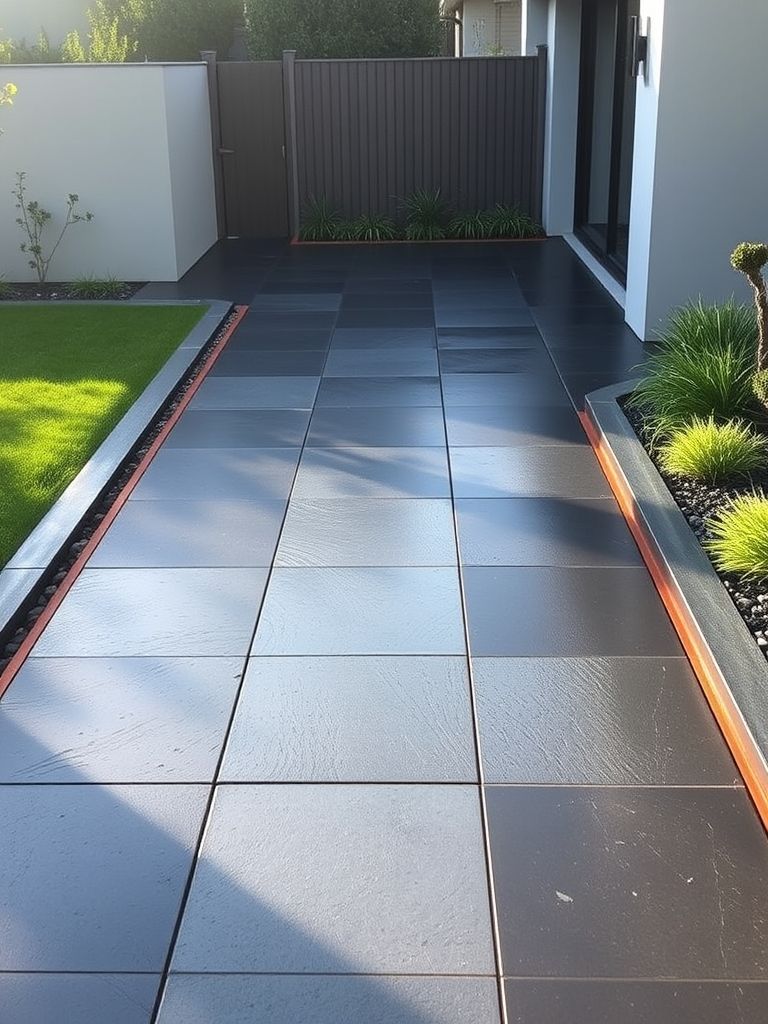
6) Ribbon Driveway with Native Groundcover
Use a high-strength concrete mix with a light broom finish for traction. Keep each ribbon around 18–24 inches wide for easy navigation. A gentle crown or crossfall prevents water pooling between strips. The center strip thrives with low, sun-loving groundcovers like creeping thyme or native sedges. Choose species that tolerate occasional foot traffic and heat reflected from concrete.
Steel or aluminum edging keeps lines true and grass from migrating. Where the ribbons meet the road, flare them subtly for smooth entries. Maintenance is mostly trimming and occasional reseeding. The payoff is a softer, cooler approach that reads eco-conscious and architecturally clean.
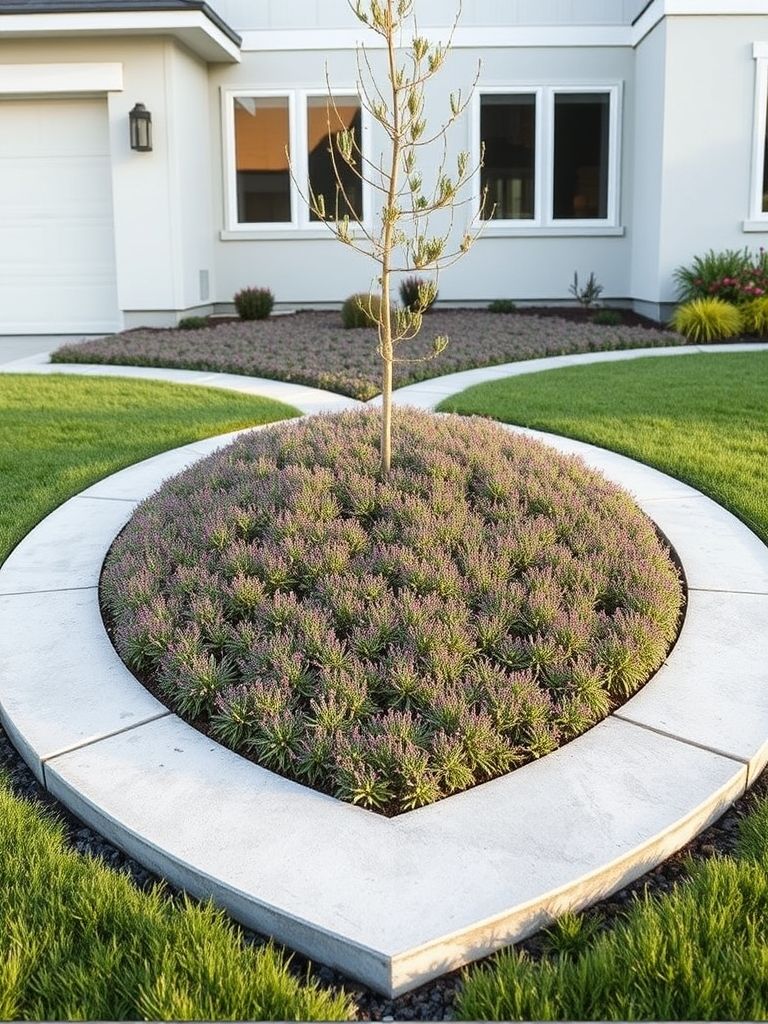
7) Grasscrete / Turf-Block Pattern for Green Coverage
Prepare a well-draining base with sandy loam in the cells. Select a hardy turf or no-mow blend suited to your climate. A light layer of compost improves establishment. Irrigation helps during hot spells, especially in the first season. Consider subsurface drip for clean lines and efficient water use. Avoid overspray that stains adjacent hardscape.
Keep the grid edges straight with steel or stone borders. A mitered return at the garage door looks professional and resists crumbling. Mow high and feed lightly to discourage thatch. Over time, the grid softens visually while still carrying vehicle loads.
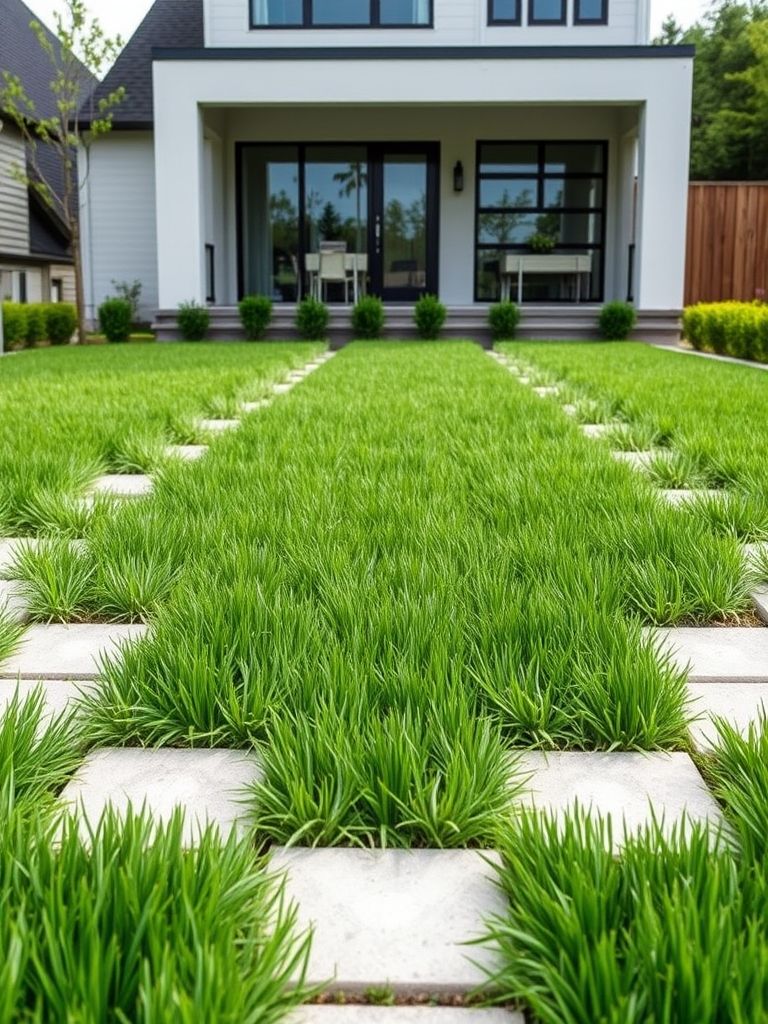
8) Linear Concrete Bands with Gravel Infills
Plan band widths with your wheelbase in mind. Wider concrete under tires with narrower gravel in between keeps maintenance low. Use angular stone so the infill locks and stays put. Reinforce concrete bands with rebar and maintain consistent thickness. Saw-cut joints between sections control cracking and keep the pattern sharp.
Gravel strips double as drainage channels during storms. Slightly recess them to collect and slow runoff before it reaches the street. Flank the composition with low mounds of grasses or groundcovers. The soft borders prevent the pattern from feeling too rigid.
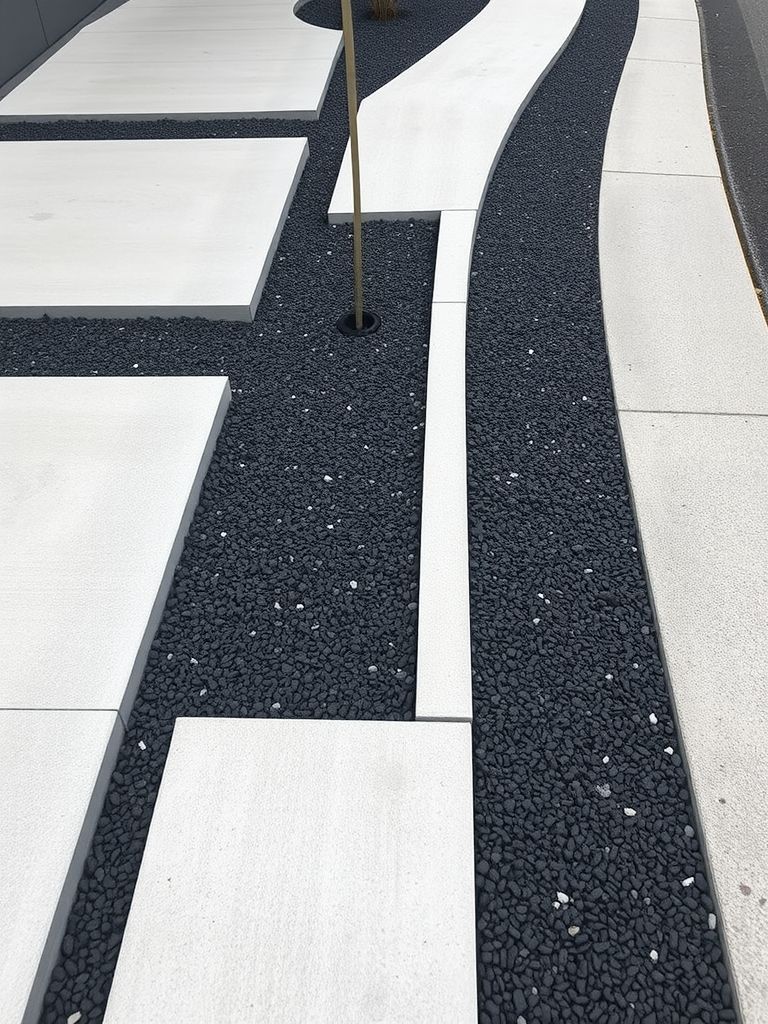
9) Hexagonal Pavers in a Monochrome Palette
Mix two close greys randomly for a natural stone vibe. Keep contrast low to avoid a jarring, mosaic look. The field should feel calm from curb distance. A single soldier-course border in the darker grey frames the field. It also simplifies cuts at edges and doors. Maintain tight, consistent joint lines throughout.
Set pavers on a well-compacted base with edge restraints. Use polymeric sand for stability and easy cleaning. Slight slopes toward discreet drains handle stormwater. Pair with a modern, flush threshold at the garage so tires roll smoothly. Minimal hardware and clean door panels complete the look.
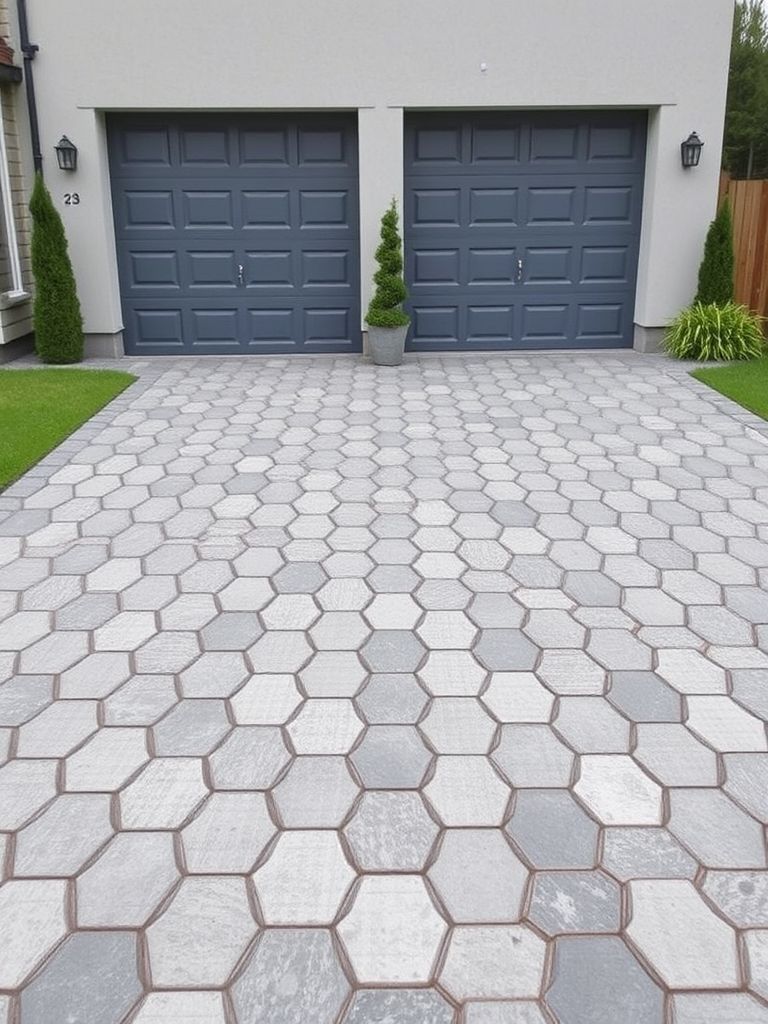
10) Corten Steel Edging with Fine Gravel Surface
Choose a dense, fine angular gravel that compacts well under traffic. A stabilized binder can reduce migration while keeping the natural look. Avoid rounded pea gravel—it scatters and ruts. Detail the edging with concealed stakes or welded tabs so the top line stays perfectly true. Straightness is what makes the composition feel high-end.
Rake periodically to refresh texture and erase tire marks. A wide broom or landscape rake can restore the plane in minutes after deliveries. Use simple, drought-tolerant planting to keep focus on form. One sculptural tree or boulder is enough for a restrained, modern statement.
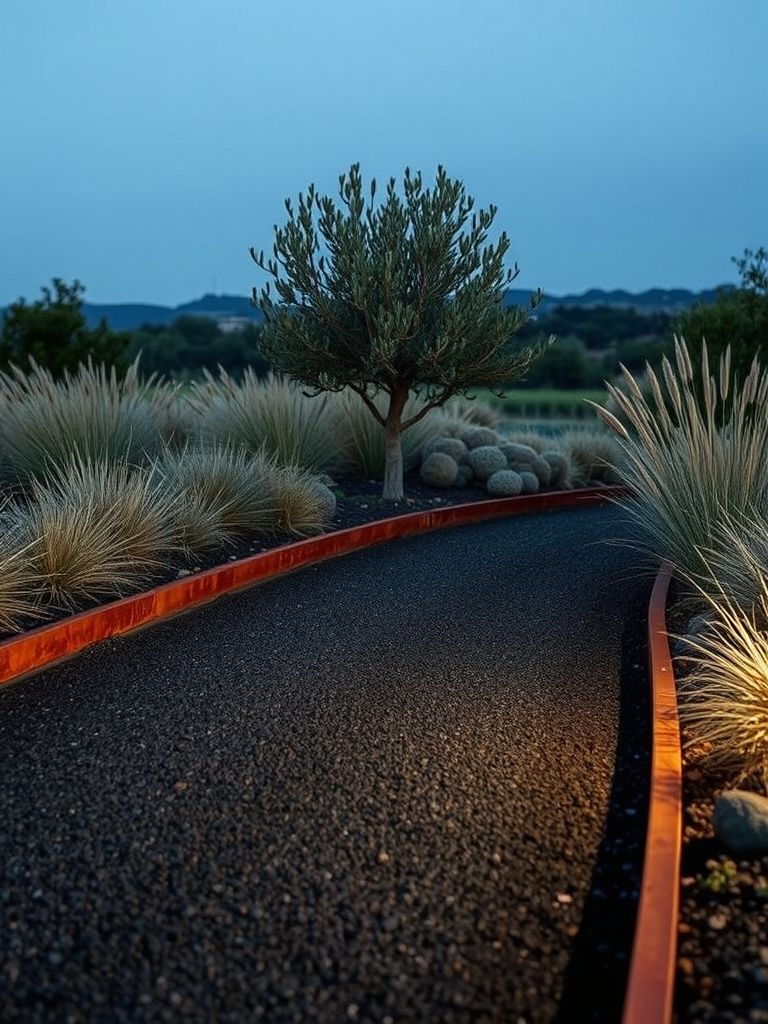
11) Floating Slab Driveway with LED Edge Lighting
Pad size should balance turning needs with clean sightlines. Keep joints wide enough for gravel or planting to breathe visually. Chamfered edges resist chipping from tight maneuvers. Install low-voltage, outdoor-rated LED channels flush to the slab underside. Warm 2700–3000K light skims downward, avoiding glare into the street. Shielding is essential for neighbor-friendly glow.
Gravel joints act as linear drains, reducing surface runoff. Use a geotextile underlayment to prevent fines from migrating upward. By day, the jointing reads sculptural; by night, it’s theatrical. The driveway becomes a gentle wayfinding tool that guides cars and guests to the entry.
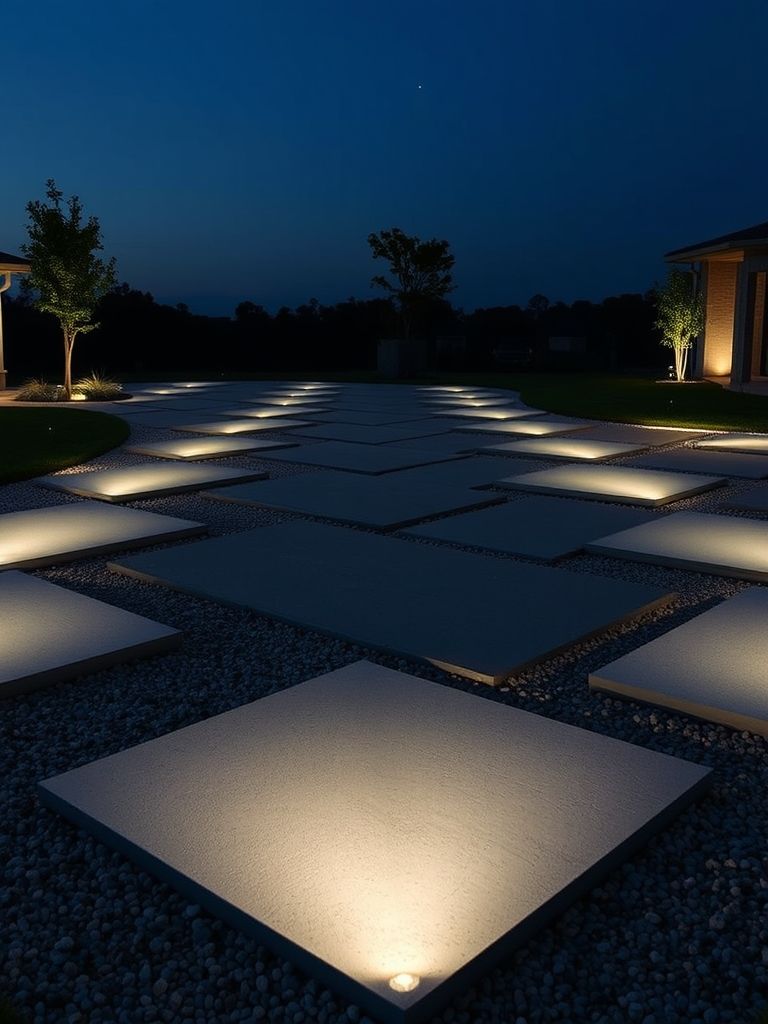
12) EV-Ready Driveway with Integrated Charging
Choose a pedestal or wall unit that matches your facade finishes. Matte black or silver tends to disappear against modern cladding. Provide night lighting that’s sufficient but not glaring. Run conduit beneath the driveway during construction so future upgrades are painless. Oversize the conduit to accommodate thicker cables and tech changes.
Provide a small apron or reinforced pad where the car typically stops. This reduces surface wear and keeps tire marks confined and cleanable. Add wayfinding cues—subtle paint dot, inlay, or contrasting paver—so drivers align perfectly with the charger every time.

13) Heated Driveway with Snow-Melt System
Coordinate zones so only critical paths heat—tire tracks, approach slopes, and entries. Zoning reduces energy use while maintaining function. Insulate below the heating system to push warmth upward. A smart controller tied to moisture and temperature sensors turns heat on only when needed.
Select surface materials compatible with heat cycles. Many paver systems and air-entrained concretes perform well if properly detailed. Plan for service access to manifolds or electrical connections. Good documentation during install makes future maintenance straightforward.
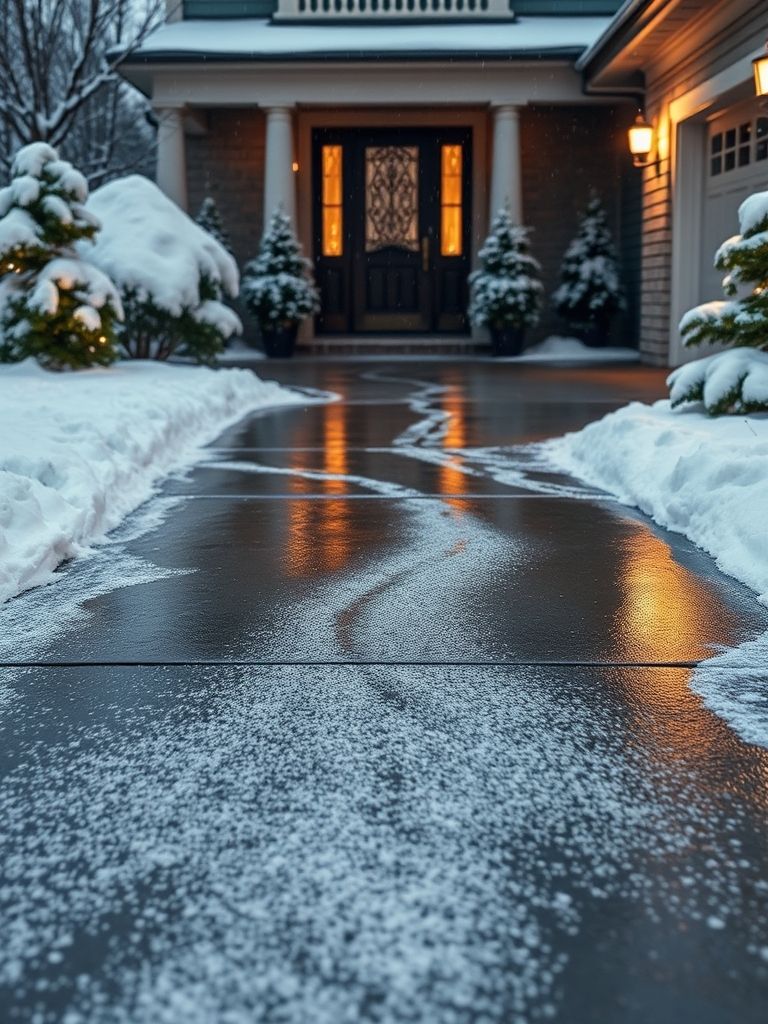
14) Curved Approach with Flanking Rain Gardens
Set the curve radius generous enough for comfortable turning without tire scrub. Align views so each bend reveals the front door or a specimen tree. Rain gardens capture and cleanse runoff from the drive. Use a mix of native grasses, sedges, and flowering perennials suited to wet-dry cycles. A river rock base provides structure and sparkle.
Add subtle bridges or stepping stones where paths cross the swales. These are opportunities for lighting accents and photo-worthy details. Maintenance is mostly seasonal cutbacks and debris clearing after storms. The planted basins age beautifully and support pollinators.
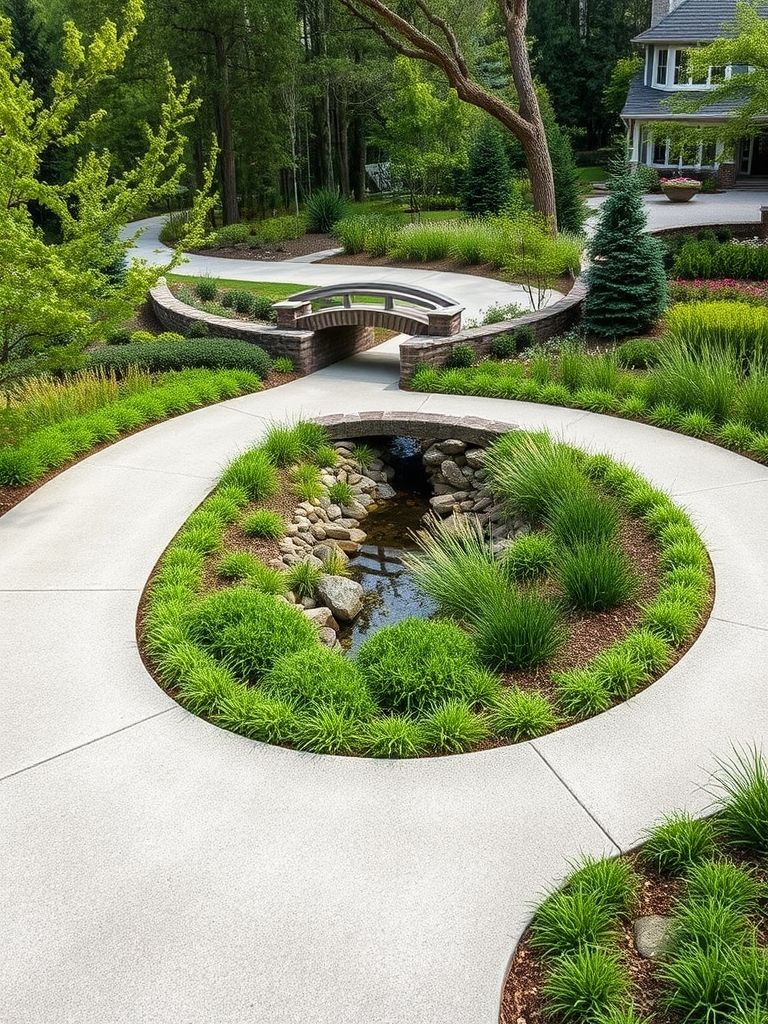
15) Motor Court with Circular Turnaround and Inlay
Keep materials restrained—one field, one border, and a simple accent. Too many textures feel busy from above and at ground level. Symmetry around the circle calms the composition. Dimension the circle so vehicles complete a clean 180 without multi-point turns. Templates or cones during layout prevent surprises on pour day.
Integrate a discreet drain at the low point of the circle. A radial slot drain can vanish inside the pattern while collecting water efficiently. Frame the court with uniform hedging and low uplights. At night the circle becomes a soft, welcoming stage for arrivals.
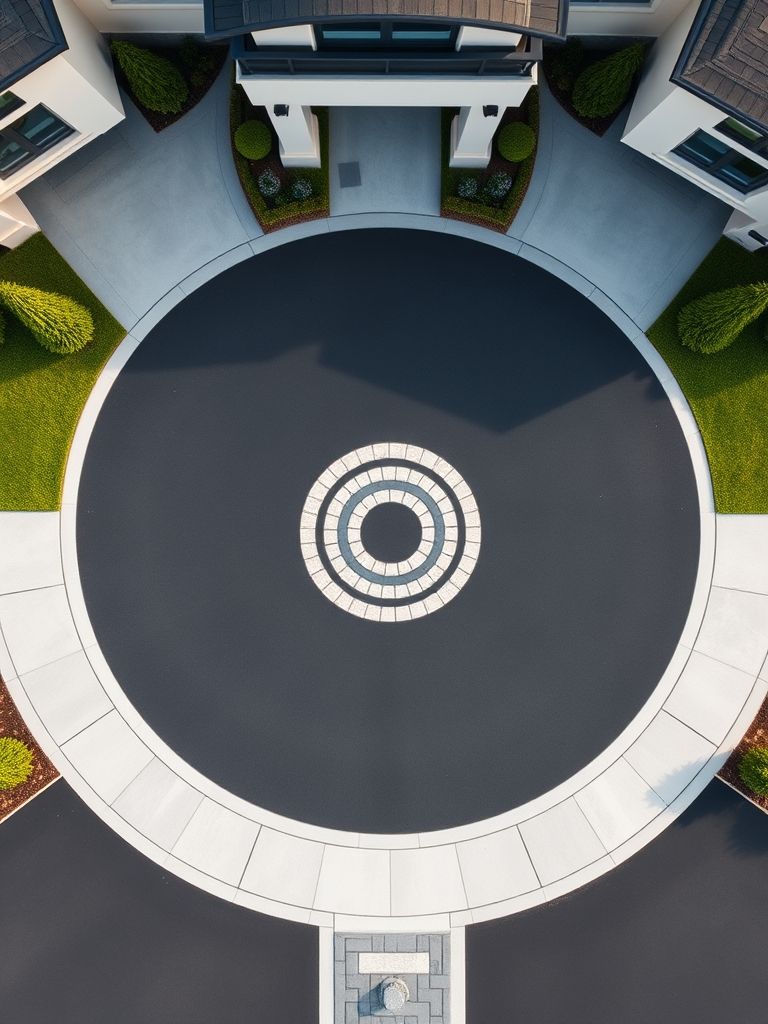
16) Reclaimed Brick in Crisp Herringbone
Lay bricks on a stabilized base with edge restraints to prevent creep. Keep joints slim and consistent, sweeping in polymeric sand for stability. A straight soldier course around the perimeter frames the field and simplifies cuts. Align the pattern to the front door axis for visual order.
Seal lightly to reduce staining while maintaining brick texture. Matte finishes feel appropriate; glossy sealers can look dated. Pair with minimalist planting and black hardware at the garage. The contrast between heritage material and modern detailing feels deliberate and fresh.
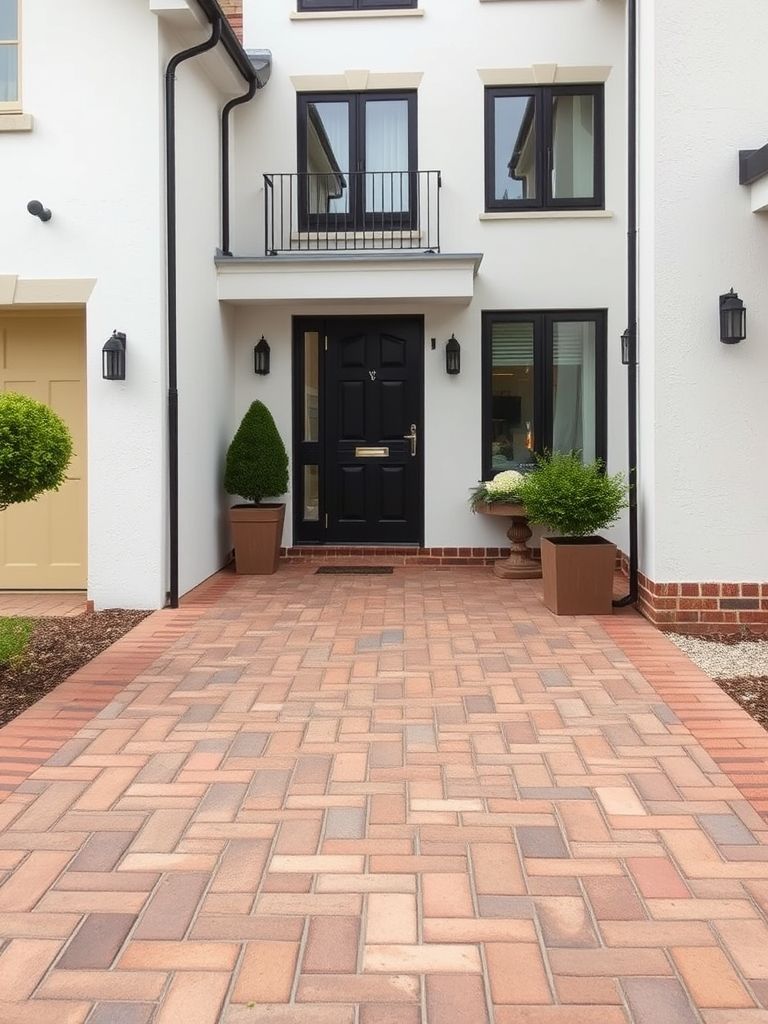
17) Architectural Gate and Address Plinth
Choose gate slat spacing that screens without feeling fortress-like. Powder-coated aluminum resists corrosion and keeps weight manageable for automation. Set the plinth on the driver’s approach side for easy visibility. Embed a low-voltage conduit during driveway work to power numbers and intercoms.
Keep paving joints aligned with the gate lines to avoid visual clashes. The rhythm between ground and vertical elements matters. Finish with a small pull-off or lay-by for deliveries. Practical touches make modern design feel considerate, not precious.
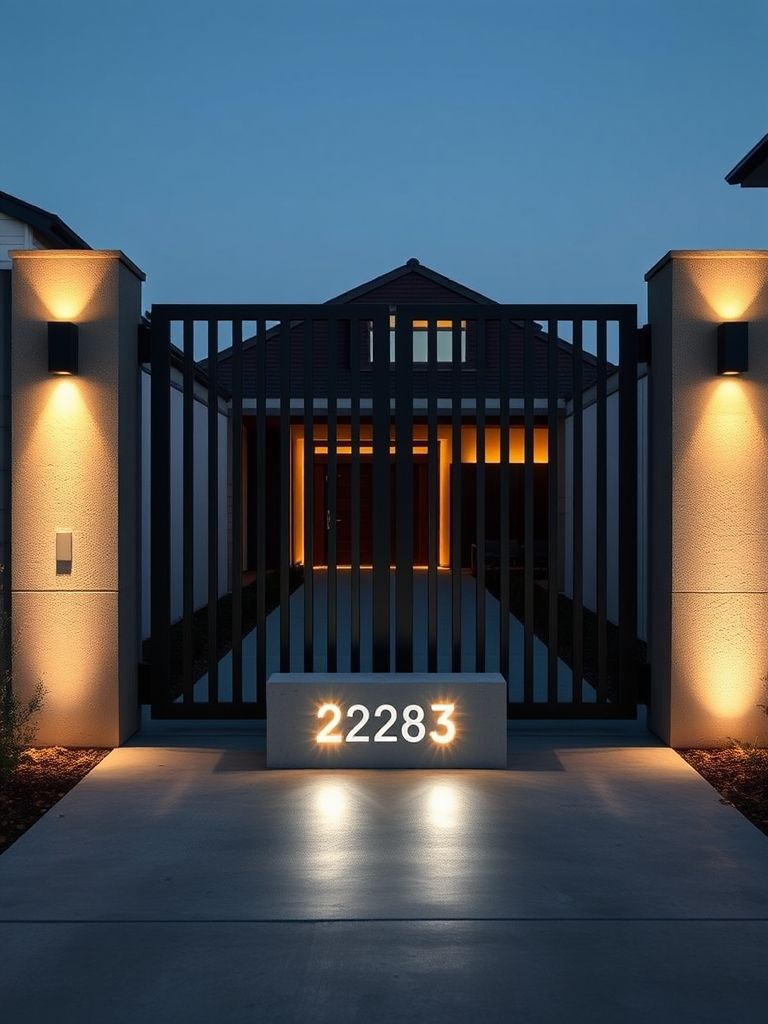
18) Discreet Drainage with Linear Channel Grates
Slope the slab gently toward the channel—about 1–2%. Keep the grate aligned with a control joint so function and pattern coincide. Select a grate finish that matches other metalwork—stainless, blackened steel, or anodized aluminum. Consistency makes the detail feel intentional.
Size the channel for local storm events and nearby roof runoff. Oversizing a touch is cheap insurance against extreme weather. Maintain by lifting the grate seasonally and clearing debris. Five minutes of care protects the whole slab from pooling and staining.
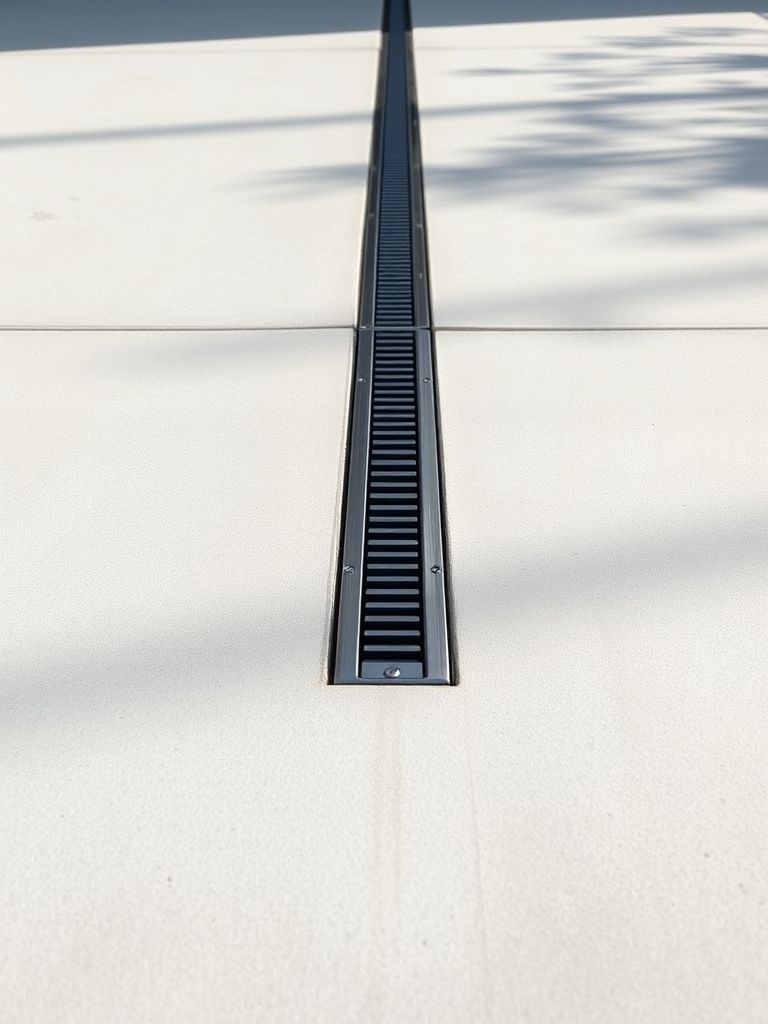
19) White Concrete with Charcoal Edge Frame
Specify a white cement and light aggregates to achieve the tone. Mock-ups help dial in finish—light sandblast or micro-etch to reduce glare and improve traction.
The dark border can be a separate pour or a contrasting paver soldier course. Either way, keep reveals tight and corners perfect; precision is the look.
Plan for oil and tire mark management with a penetrating sealer. A scheduled gentle wash keeps the field pristine without harsh chemicals.
Pair with restrained planting—clipped hedges, architectural grasses, and a single specimen tree. The simplicity lets the hardscape shine.
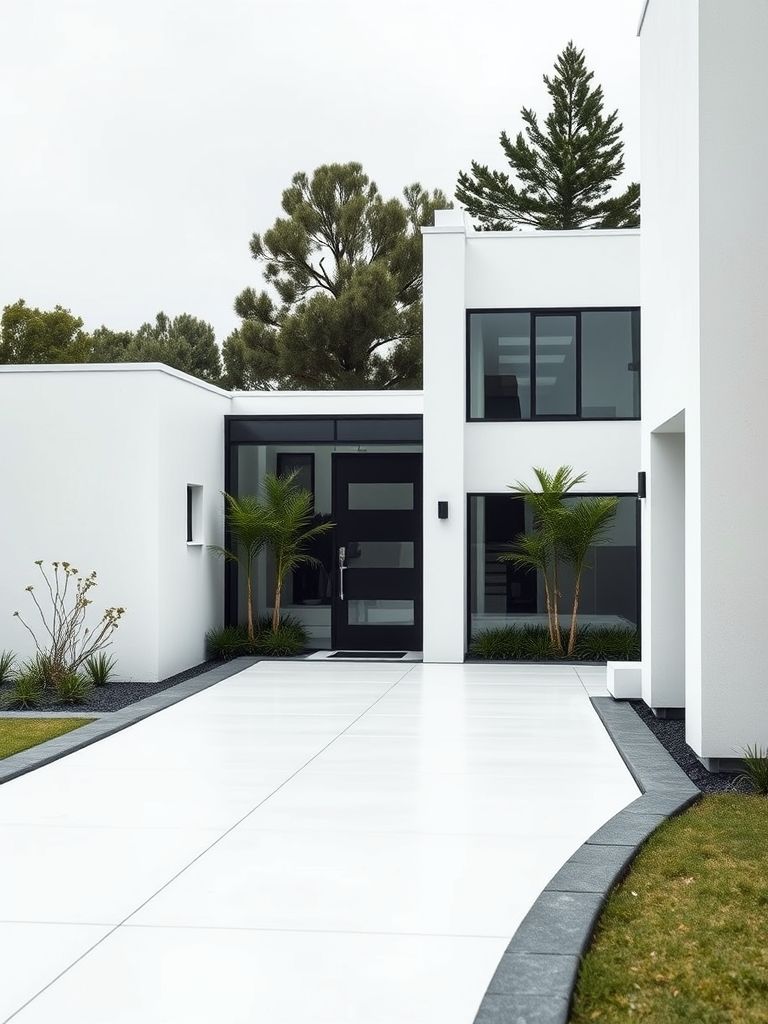
20) Mixed-Media Drive: Concrete, Timber Accents, and Stone
Limit the number of transitions to maintain legibility. Use timber as narrow inlays or transitions at pedestrian zones, not under heavy tire paths. Composites can substitute for durability where weather is harsh.
A split-face stone band at the apron acts like a welcome mat. It hides scuffs from street tires and introduces vertical facade materials at the ground plane.
Detail movement joints where materials meet. Different expansion rates demand flexible sealants and clear breaks to avoid cracking.
Light the composition sparingly—grazing stone, a glow at the timber, and a soft wash across concrete. At night the surface becomes a quiet study in texture.
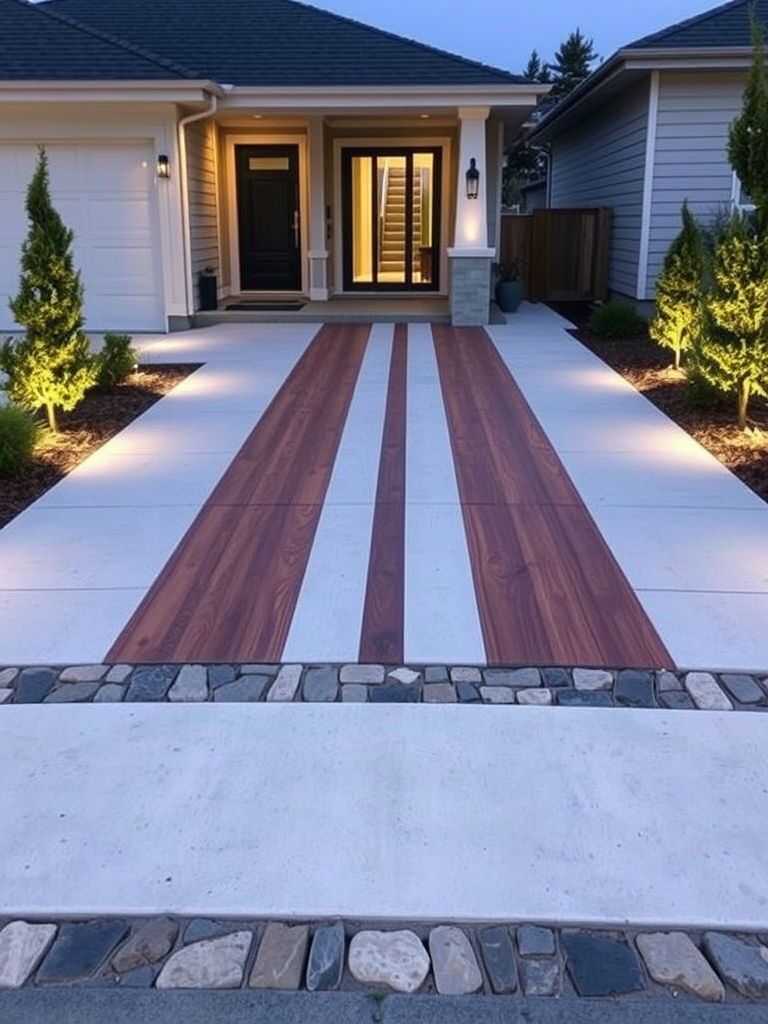
Conclusion on Modern Driveway Ideas
Modern driveway ideas go far beyond just providing a path for vehicles—they set the tone for your home’s entire exterior. From sleek concrete finishes and geometric pavers to creative use of lighting and landscaping, the right design blends functionality with curb appeal. A well-planned driveway not only makes your home more practical but also adds long-term value and charm.
Whether you prefer minimalist lines, eco-friendly materials, or a bold statement design, modern driveways offer endless possibilities to suit your taste and lifestyle. By investing in thoughtful details, you can create an entrance that welcomes guests, enhances your property, and reflects your unique style.



